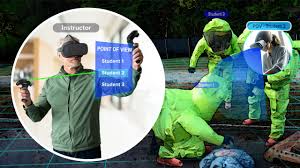VR in Disaster Response Training
Preparing Responders for Real-World Scenarios
Imagine a world where first responders can practice responding to a simulated earthquake, fire, or flood without any real-world risks. This is the power of virtual reality (VR) in disaster response training. VR allows responders to experience realistic and immersive scenarios, helping them develop critical skills and confidence in a safe and controlled environment.
VR in Disaster Response Training: Preparing Responders for Real-World Scenarios
-
VR in Disaster Response Training
Imagine a world where first responders can practice responding to a simulated earthquake, fire, or flood without any real-world risks. This is the power of virtual reality (VR) in disaster response training. VR allows responders to experience realistic and immersive scenarios, helping them develop critical skills and confidence in a safe and controlled environment.
-
Preparing Responders for Real-World Scenarios
VR training provides responders with a unique opportunity to:
- Practice decision-making in high-pressure situations. VR simulations can replicate the chaotic and unpredictable nature of disaster events, pushing responders to think critically and make quick decisions under duress.
- Enhance teamwork and coordination. VR allows multiple responders to participate in the same simulation, fostering collaboration and communication skills essential for effective disaster response.
- Gain hands-on experience with different equipment and procedures. Responders can familiarize themselves with various tools and techniques in a virtual environment, reducing the learning curve and improving their operational efficiency.
- Explore different scenarios and learn from mistakes. VR simulations allow responders to practice different disaster scenarios, analyze their performance, and learn from mistakes without any real-world consequences.
By providing a safe and controlled environment for training, VR empowers responders to develop the necessary skills, knowledge, and confidence to handle real-world disaster situations effectively.
Summary:
- VR training in disaster response offers a safe and realistic way for responders to practice critical skills and decision-making under pressure.
- VR simulations enhance teamwork, communication, and familiarity with equipment and procedures.
- By allowing responders to learn from mistakes in a virtual environment, VR fosters improvement and better preparedness for real-world disasters.
